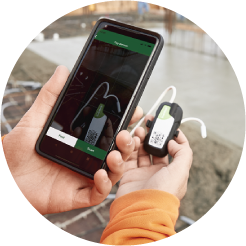
The conditions made it extremely difficult, if not unrealistic, for field-cured cylinders to capture the accurate in-place strength results required. With a tight schedule to maintain, the time-consuming process of cylinder break tests was not meeting our needs, nor the building owners'.
WILLIAM PETTIT, PROJECT MANAGER, BOTTORFF CONSTRUCTION INC.

Activate the sensor and tag each one in your SmartRock app by project and section.

Secure the sensor to the rebar in the formwork and pour concrete as usual.

Open the SmartRock app to view concrete strength and temperature data in real-time or remotely using SmartHub.
SmartRock™ sensors for concrete temperature monitoring are the industry’s top choice for concrete monitoring
- Used in more construction sites around the world than any other concrete strength measurement sensor,
- Dual-temperature monitoring capabilities,
- A concrete strength test in compliance with industry standards (ASTM C1074), and is accepted by DOTs,
- Allows you to create projects faster than concrete cylinder testing,
- Rugged and waterproof; designed to withstand the toughest conditions,
- Instant wireless connection to your smartphone,
- User-friendly mobile app displays temperature, strength, maturity info, and more,
- Data sharing of full PDF or CSV reports with all project stakeholders,
- Track and review all projects with the cloud-based dashboard.
Live Overview
Mix Calibrations
Project Management
Data History
Live Overview
Mix Calibrations
Project Management
Data History
The Official Definition of a Low Concrete Cylinder Break
Under ACI and CSA Standards, a break is considered to be of low compressive strength when an individual strength test (average of two cylinders) is more than 500 psi (3.5 MPa) below the required expected strength. Or, if the averages of all three consecutive sets of tests does not equal or exceed expected strength of the mix design. These nationally accepted specifications do account for normal and expected variability of concrete strength tests. However, if your samples exceed these specified values, more investigation into the cause is required.
The World's Top Construction Teams Trust SmartRock
“There's no doubt that SmartRock saves an unbelievable amount of time and money for the contractor — and takes the maturity method to the next level.”
 |
Walt III, Secretary and Treasurer, Flood Testing Laboratories |

Walt III, Secretary and Treasurer, Flood Testing Laboratories
“For me personally, the project I go to, whether it's a bridge, a low-rise construction, or a high-rise building, if I'm pouring concrete, I'm going to seriously think about using this technology [SmartRock] rather than field cures — just because I have seen the advantages first hand.”
 |
Shawn Kitt, Superintendent, PCL Construction |

Shawn Kitt, Superintendent, PCL Construction
“Depending on how many phases and the number of pours, you can save days on some jobs and weeks on others [using SmartRock].”
 |
Ryan Gulbrandson, Project Manager, T&R Contracting |

Ryan Gulbrandson, Project Manager, T&R Contracting
“Once the SmartRock sensors were installed, we didn't look back...”
 |
Steve Pirello, Project Manager, S&F Concrete Contractors |

Steve Pirello, Project Manager, S&F Concrete Contractors

